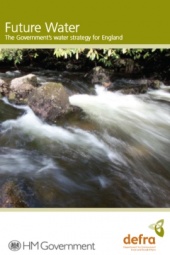Future Water, The Government’s water strategy for England
In 2008, the government published Future Water, The Government’s water strategy for England. The strategy was published as a response to the 2004-06 South East of England droughts and the floods of 2007. It set out the government’s vision for the water sector in 2030 and the measures proposed to help deliver that vision.
In the Foreword, the then Secretary of State for Environment, Food and Rural Affairs, Hilary Benn said:
“In England, the average person uses about 150 litres of water a day – that’s about a tonne a week!... The South East and East of England already face increasing demand on a finite water supply. The drought of 2004-06 was only managed through controls on what we could use water for. This was not a one-off; indeed droughts are likely to be more common. By 2080, some long term climate projections forecast half as much rainfall in summer (nothing like fully offset by 30% more rainfall in winter) in the South East. We need to plan ahead and each of us needs to play our part…. We have, of course, not only to cope with too little water. Indeed the last year has been characterised more by too much water with serious flooding in many parts of the country. Sir Michael Pitt’s report into these floods shows that we still have lessons to learn as a country about defending ourselves from, and learning to live with, floods.”
The document describes ‘...a vision of a sector that values and protects its water resources; that delivers water to customers through fair, affordable and cost-reflective charges; where flood risk is addressed with markedly greater understanding and use of good surface water management; and where the water industry has cut its greenhouse gas emissions.’ This includes:
- The sustainable delivery of stable water supplies.
- Clean water available for nature, people and business.
- An improved and protected water environment.
- An improvement in canals, lakes, rivers and seas for people and wildlife which benefits angling, sailing and other recreational past times.
- Appropriate water charging.
- Action for flood risk through the appropriate use of good surface water management.
- A reduction in greenhouse gas emissions from the water sector.
- An understanding and resilience to climate change including the likely increase in the frequency of droughts and flooding and the rise in population levels.
The document is divided into the following sections:
- Ministerial Foreword.
- Executive Summary.
- Chapter 1 – Future water.
- Chapter 2 – Water demand.
- Chapter 3 – Water supply.
- Chapter 4 – Water quality in the natural environment.
- Chapter 5 – Surface water drainage.
- Chapter 6 – River and coastal flooding.
- Chapter 7 – Greenhouse gas emission.
- Chapter 8 – Charging for water.
- Chapter 9 – Regulatory framework, competition and innovation.
- Chapter 10 – Summary of vision and actions.
[edit] Related articles on Designing Buildings
- Catchment flood management plans.
- Flood.
- Flood and Water Management Act.
- Flood insurance.
- Flood Re.
- Flood risk management plans.
- Flood risk.
- Marine energy and hydropower.
- Pitt Review Lessons learned from the 2007 floods.
- Planning for floods.
- River engineering.
- Sustainable urban drainage systems (SUDS).
- Water engineering.
[edit] External references
Featured articles and news
Homes England supports Greencore Homes
42 new build affordable sustainable homes in Oxfordshire.
Zero carbon social housing: unlocking brownfield potential
Seven ZEDpod strategies for brownfield housing success.
CIOB report; a blueprint for SDGs and the built environment
Pairing the Sustainable Development Goals with projects.
Types, tests, standards and fires relating to external cladding
Brief descriptions with an extensive list of fires for review.
Latest Build UK Building Safety Regime explainer published
Key elements in one short, now updated document.
UKGBC launch the UK Climate Resilience Roadmap
First guidance of its kind on direct climate impacts for the built environment and how it can adapt.
CLC Health, Safety and Wellbeing Strategy 2025
Launched by the Minister for Industry to look at fatalities on site, improving mental health and other issues.
One of the most impressive Victorian architects. Book review.
Common Assessment Standard now with building safety
New CAS update now includes mandatory building safety questions.
RTPI leader to become new CIOB Chief Executive Officer
Dr Victoria Hills MRTPI, FICE to take over after Caroline Gumble’s departure.
Social and affordable housing, a long term plan for delivery
The “Delivering a Decade of Renewal for Social and Affordable Housing” strategy sets out future path.
A change to adoptive architecture
Effects of global weather warming on architectural detailing, material choice and human interaction.
The proposed publicly owned and backed subsidiary of Homes England, to facilitate new homes.
How big is the problem and what can we do to mitigate the effects?
Overheating guidance and tools for building designers
A number of cool guides to help with the heat.
The UK's Modern Industrial Strategy: A 10 year plan
Previous consultation criticism, current key elements and general support with some persisting reservations.
Building Safety Regulator reforms
New roles, new staff and a new fast track service pave the way for a single construction regulator.























